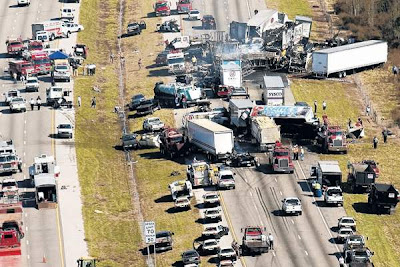Last year Wildfire Today covered the January 9 escaped prescribed fire near Interstate 4 between Orlando and Tampa. An unexpected drop in the relative humidity, according to Division of Forestry investigators, caused the 50-acre project to get out of control and burn an additional 200 acres and one of their dozers. The smoke mixed with fog and reduced visibility on Interstate 4, causing a 70-vehicle accident that claimed the lives of 5 people.
Friday the eleventh of 12 reports about the accident, covering 24 of the 70 vehicles, was released. Here are some excerpts from The Ledger:
No charges will be filed in the biggest crash that claimed the most lives in last year's massive Interstate 4 pileup, prosecutors said Friday.
Smoke, fog and human error led to the 24-vehicle crash that left four people dead, according to a report released on Friday by the Florida Highway Patrol.
Visibility was very poor, investigators wrote, but the fact that a number of drivers were able to stop, pull over and avoid a collision shows that some crashes during the morning of Jan. 9, 2008, could have been avoided.
The report released Friday dealt with one of a series of crashes that happened that morning, when, in all, 70 cars collided on I-4 in dense fog and smoke.
Over and over, drivers told FHP they drove into a wall of smoke and fog, the report shows. But investigators attributed most crashes to drivers not slowing down enough.
"As bad as the conditions were at the scene, it was possible to avoid crashing into other vehicles," the report said. "Those vehicles that were able to stop were then involved in this crash due to the careless driving of others."
The report concluded the smoke came from a nearby wildfire that had started when a controlled burn set north of I-4 by the Florida Fish and Wildlife Conservation Commission got out of control as weather conditions changed unexpectedly.
Agriculture Commissioner Charles Bronson said a month after the crash that the smoke from the fire played no part in the near-zero visibility. And at the time, some officials said fog alone was to blame or that smoke from burning vehicles in the first crashes contributed to problems for later drivers.
But the FHP report backs up what was said by drivers involved in the crashes, including a Polk County sheriff's deputy, who insisted they were nearly blinded by a combination of smoke and fog.
There has been one lawsuit over the pileup filed in Polk County against the wildlife commission. There have been five other lawsuits among drivers and companies that owned vehicles in the crashes.
[...]
INVESTIGATING THE FIRE
After the accidents, the state has investigated whether there were mistakes involving the controlled burn that grew into the wildfire and contributed to the wrecks.
But state officials maintain everything went by the book and that the book doesn't need changing. Unpredictable weather changes are to blame, they say.
Division of Forestry spokesman Gerry LaCavera said conditions were fine to start the burn in the Hilochee Wildlife Management Area off I-4. The forestry division was responsible for issuing wildlife commission workers the permit for the controlled burn.
State investigators say the problem started when humidity dropped unexpectedly, and flames began to jump the controlled burn's lines.
LaCavera said there haven't been any changes at the Division of Forestry since the crashes last year.
"We haven't seen a new need for them," LaCavera said.
He said people within the Division of Forestry check forecasts each morning before issuing burn permits.
"It is based on the best information," LaCavera said.
On Friday, Gary Morse, a spokesman with Fish and Wildlife, declined comment, citing legal action some of the drivers have taken against Fish and Wildlife.






No comments:
Post a Comment